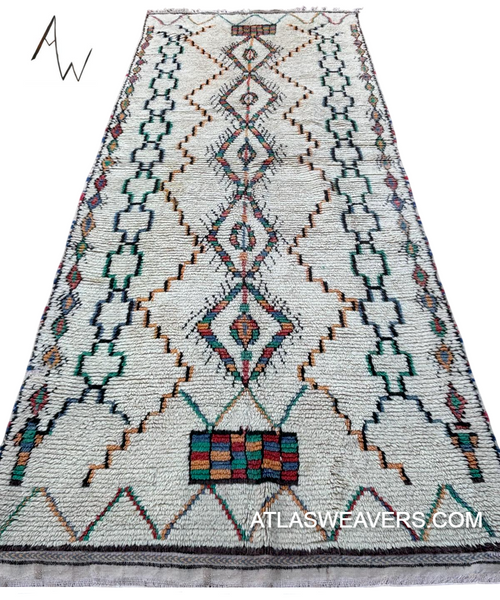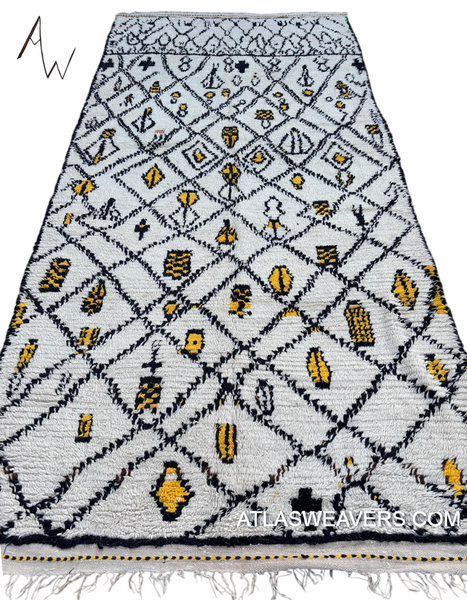Complimentary shipping
Hand Knotted Berber Rug
Studio photos & Outdoors
Size 9x12
100% wool
CUSTOM MADE
For most discerning rug buyers, we fulfill custom orders for rugs produced from scratch. Hand spun wool, in the Atlas mountains of Morocco by the Berbers to keep the Beni Ourain tradition genuine. If you have a specific size and design in mind, please inquire.
RETURNS
We offer our customers a two week return policy, 100% money back guarantee. One year trade policy for other sizes or designs.
Welcome to Atlas Weavers! We provide high quality hand-knotted Moroccan rugs at great prices. Our quality is often imitated but never matched.
By Raz
Moroccan rug motifs influenced designers such as Ivan Da Silva Bruhn and Vladimir Boberman. American Interior Designer Francis Elkins used them in some of her most notable interiors in the 1930’s and 1940’s.
Some of my influences, Henri Matisse 1915 Morocco, in his collection Matisse in Morocco, Renoir, The Jewish Wedding in Morocco (after Delacroix) "Eugene Delacroix" and others, like Pablo Picasso. As each one is deeply rooted in history, Morocco is rooted in me, the imagery is expressed in my creations. Morocco is a land that forever imprints itself upon may artist's, myself included, to inspire beauty. In the words of Henri Matisse about Morocco, he felt himself "transported into a kind of paradise.", one reference stated that he discovered in that alien land an otherworldly Eden that forever after gripped his colored dreams.
“Language is the essence of one’s ethnicity, one’s roots”… hence the reason my father wanted me to learn how Berbers communicate. When I was in fourth grade, he sent me to live with my Aunt in the high mountains, the area now known as the Middle Atlas. As an artisan weaver, she tasked me with measuring the living rooms of her customers. With pride and curiosity, I walked heel-toe across the rooms just as my aunt had taught me. She and her artisan friends wove the finest rugs and as I watched them work the looms, sometimes pulling thread gracefully and other times forcefully, I learned not only the spoken language of the Berber, I learned the visual language.
The symbolism of the Berber tradition is often referred to as the “Infinite Rapport”, meaning the pattern and the spirit of the work extends beyond its physical borders. Many examples of Berber carpets show shifts in the pattern, reflecting a change in life events, a different weaver taking over the rug or spontaneous creative expression. As many Berber women believe the rugs are imbued with a spirit, either from the imprint of the artist or from the living nature of the wool, they resist monitoring the progression of their work, often revealing the entire rug only after it has been completed. Once the deeply laborious weaving process is completed, the finished rugs are considered part of the family and are the prized possession of the home.
The Berbers carefully preserve their heritage of technique and knowledge passing down messages in wool from one generation to another. While preserving history, the elemental nature of Berber weaving is an execution of pure instinct. Weaving is not only an inherent rite of passage but also an act of expression. The women that manifest these works have a story to tell: while some rugs document a personal experience, other weavings carry a more ancestral message passed down over time. Many of the artists' artisans weave their tales organically, while others intentionally channel inherited knowledge into the loom. The life rituals of the Berber women, including fertility, birth, and the protective role of men, are narrated in an abstract form. It is pure coincidence that the Berber carpets, with their simplistic form and geometric purity, appear modern to the Western eye.
As native Berber immigrants in the U.S., it is our mission to bring the rich tradition and culture of the Berber people into Western living spaces.
Only 1 available
















